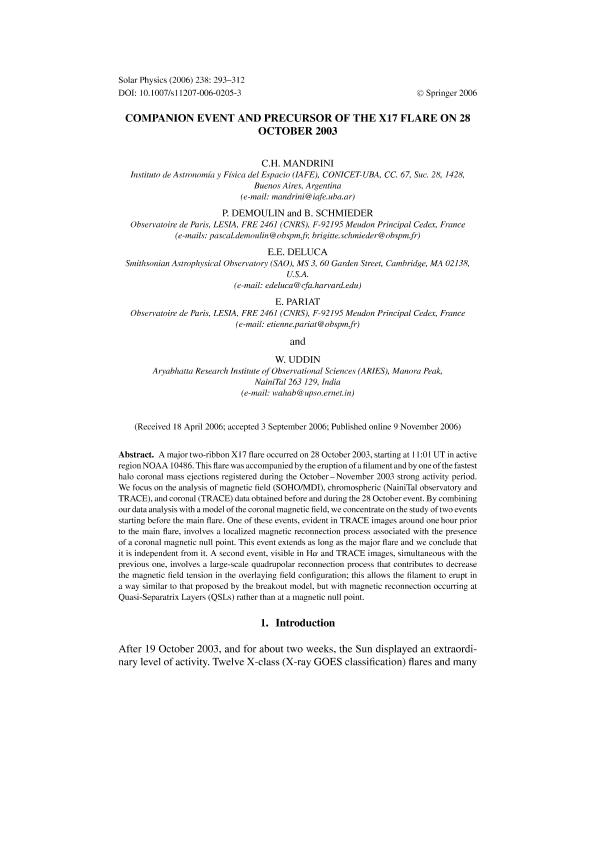Mostrar el registro sencillo del ítem
dc.contributor.author
Mandrini, Cristina Hemilse

dc.contributor.author
Démoulin, Pascal

dc.contributor.author
Schmieder, B.
dc.contributor.author
Deluca, E. E.
dc.contributor.author
Pariat, E.
dc.contributor.author
Uddin, W.
dc.date.available
2017-05-18T19:20:29Z
dc.date.issued
2006-12
dc.identifier.citation
Mandrini, Cristina Hemilse; Démoulin, Pascal; Schmieder, B.; Deluca, E. E.; Pariat, E.; et al.; Companion Event and Precursor of the X17 Flare on 28 October 2003; Springer; Solar Physics; 238; 2; 12-2006; 293-312
dc.identifier.issn
0038-0938
dc.identifier.uri
http://hdl.handle.net/11336/16663
dc.description.abstract
A major two-ribbon X17 flare occurred on 28 October 2003, starting at 11:01 UT in active region NOAA 10486. This flare was accompanied by the eruption of a filament and by one of the fastest halo coronal mass ejections registered during the October November 2003 strong activity period. We focus on the analysis of magnetic field (SOHO/MDI), chromospheric (NainiTal observatory and TRACE), and coronal (TRACE) data obtained before and during the 28 October event. By combining our data analysis with a model of the coronal magnetic field, we concentrate on the study of two events starting before the main flare. One of these events, evident in TRACE images around one hour prior to the main flare, involves a localized magnetic reconnection process associated with the presence of a coronal magnetic null point. This event extends as long as the major flare and we conclude that it is independent from it. A second event, visible in Há and TRACE images, simultaneous with the previous one, involves a large-scale quadrupolar reconnection process that contributes to decrease the magnetic field tension in the overlaying field configuration; this allows the filament to erupt in a way similar to that proposed by the breakout model, but with magnetic reconnection occurring at Quasi-Separatrix Layers (QSLs) rather than at a magnetic null point.
dc.format
application/pdf
dc.language.iso
eng
dc.publisher
Springer

dc.rights
info:eu-repo/semantics/openAccess
dc.rights.uri
https://creativecommons.org/licenses/by-nc-sa/2.5/ar/
dc.subject
Solar Flares
dc.subject.classification
Astronomía

dc.subject.classification
Ciencias Físicas

dc.subject.classification
CIENCIAS NATURALES Y EXACTAS

dc.title
Companion Event and Precursor of the X17 Flare on 28 October 2003
dc.type
info:eu-repo/semantics/article
dc.type
info:ar-repo/semantics/artículo
dc.type
info:eu-repo/semantics/publishedVersion
dc.date.updated
2017-05-16T15:11:41Z
dc.journal.volume
238
dc.journal.number
2
dc.journal.pagination
293-312
dc.journal.pais
Alemania

dc.journal.ciudad
Berlín
dc.description.fil
Fil: Mandrini, Cristina Hemilse. Consejo Nacional de Investigaciónes Científicas y Técnicas. Oficina de Coordinación Administrativa Ciudad Universitaria. Instituto de Astronomía y Física del Espacio. - Universidad de Buenos Aires. Facultad de Ciencias Exactas y Naturales. Instituto de Astronomía y Física del Espacio; Argentina
dc.description.fil
Fil: Démoulin, Pascal. Centre National de la Recherche Scientifique. Observatoire de Paris; Francia
dc.description.fil
Fil: Schmieder, B.. Centre National de la Recherche Scientifique. Observatoire de Paris; Francia
dc.description.fil
Fil: Deluca, E. E.. Harvard-Smithsonian Center for Astrophysics; Estados Unidos
dc.description.fil
Fil: Pariat, E.. Centre National de la Recherche Scientifique. Observatoire de Paris; Francia
dc.description.fil
Fil: Uddin, W.. Aryabhatta Research Institute of Observational Sciences (ARIES); India
dc.journal.title
Solar Physics

dc.relation.alternativeid
info:eu-repo/semantics/altIdentifier/doi/http://dx.doi.org/10.1007/s11207-006-0205-3
dc.relation.alternativeid
info:eu-repo/semantics/altIdentifier/url/https://link.springer.com/article/10.1007/s11207-006-0205-3
Archivos asociados
